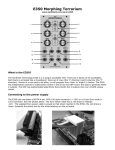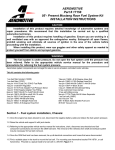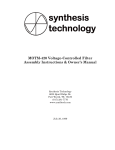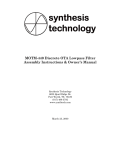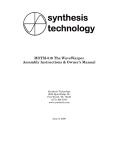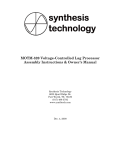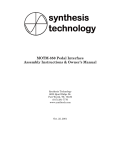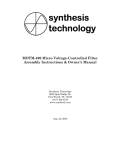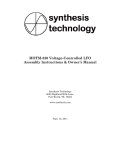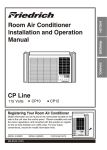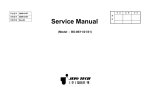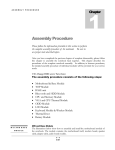Download MOTM-830 User Manual
Transcript
MOTM-830 Dual-Mode Mixer Assembly Instructions & Owner’s Manual Synthesis Technology 6625 Quail Ridge Dr. Fort Worth, TX 76180 (817) 498-3782 www.synthtech.com May 30, 2001 MOTM-830 PARTS LIST Please carefully check that all parts are in your kit. If you have a suspected shortage, please call or email. If you get free extra stuff, keep it for next time. Capacitor bag, containing the following 10 parts: 2ea 10mfd, 50V Electrolytic 4ea 22pf (marked 220) ceramic axial 4ea 0.1mfd (marked 104) ceramic axial C9, C10 C1, C6, C7. C8 C2, C3, C4, C5 Resistor bag, containing the following 24 parts: 13ea 100K 1% (brown, black, black, orange) 3ea 10K (brown, black, orange) 2ea 1K (brown, black, red) 2ea 44K2 1% (yellow, yellow, red, red) 2ea 49K9 1% (yellow, white, white, red) 1ea 150K 1% (brown, green, black, orange) 1ea 51K (green, brown, orange) R6, R9-13, R18-24 R5, R7, R16 R4, R14 R8, R17 R1, R3 R2 R15 IC bag, containing the following 3 parts: 2ea OP285GP precision dual opamp 1ea TL072 dual op amp U1, U2 U3 Misc #1 bag, containing the following 4 parts: 2ea Axial ferrite beads (plain, gray things)L1, L2 1ea MTA-156 power connector JP1 1ea SPDT (ON-ON) toggle switch M2012 SW1 Knobs, 7ea, ALCO PKES90B1/4 Jacks, containing 7ea Switchcraft 112A 1ea Switchcraft 114B (contains switch SW2) SYNTHESIS TECHNOLOGY MOTM-830 ASSEMBLY 5/30/01 WWW.SYNTHTECH.COM PAGE 2 Pots, 7ea containing the following: 3ea 100K linear conductive plastic (Bourns) 1ea 100K linear cermet (Spectrol 149) 3ea 100K log conductive plastic (Spectrol 148) VR5, VR6, VR7 VR4 VR1, VR2, VR3 Front panel Mounting bracket Wire bag, containing the following 14 wires: 6ea RG-174 coax, 4 ½ inches 2ea RG-174 coax, 7 inches 4ea 3-wire set, 22ga. 6 inches (orange/white/gray) 1ea 2-wire set, 22ga. 3 inches (red/black) 1ea Power Cable, 20” Hardware bag, containing: 4ea #8-32 x 3/8 black screws (for mounting module to rack) 4ea #6-32 x 1/2 zinc screws (for attaching pc board to bracket) 4ea 1/4 inch aluminum spacers 6ea #6 KEPS nuts (2 for attaching bracket to front panel, 4 for pc board) 3ea small heat-shrink tubing 9ea small tie-wraps Organic Solder No-clean Solder PC Board, MOTM-830 SYNTHESIS TECHNOLOGY MOTM-830 ASSEMBLY 5/30/01 WWW.SYNTHTECH.COM PAGE 3 GENERAL INFORMATION Thank you for purchasing the MOTM-830 Dual Mode Mixer. If you have any issues concerning the building or use of the kit, please contact us at (817) 498-3782 or by email: [email protected]. This kit should take the average builder between 2 and 3 hours. The kit contains many different resistors and special parts. However, please remember this is NOT a speed contest; it is an accuracy contest. There is no rule that you have to complete the entire kit in one day (as long as you wash the flux off!). Successful kit building relies on having the proper tools. Here is a list of what you will need to build your MOTM-830: • • • • • • • • • • • Soldering iron, 50W max power Needle-nose or chain-nose pliers Diagonal cutters Allen key set for securing the knobs (1/16” or 1.6mm) Magnifying glass: to read the capacitor codes and to inspect solder joints Lead bending tool (optional, but makes the job go much faster) DVM (Digital Volt Meter) or oscilloscope (to check the output) #1 Philips screwdriver Fingernail brush for washing off the organic flux Old towel for blotting dry pc board Heat-shrink gun is highly recommended! For more information of tools used and suggestions, see the MOTM FAQ and Tutorial pages at http://www.synthtech.com. HOW TO FOLLOW THE DIRECTIONS Please read the entire instruction before proceeding. There may be valuable information at the next to it. After you complete the end of the instruction. Each instruction has a check box instruction, check the box. This way you can keep track of where you are in the process. VERIFY THE PARTS LIST Verify that all of the parts are in the kit as shown on the parts list. SYNTHESIS TECHNOLOGY MOTM-830 ASSEMBLY 5/30/01 WWW.SYNTHTECH.COM PAGE 4 A WORD ON SOLDERING There are 2 very different types of solder used in the kit. Most of the soldering uses ‘Organic Flux’ solder. This is strictly for use on the pc board, and is NOT to be used on the front panel wiring! In order for solder to ‘stick’ to the copper, a chemical called ‘flux’ is embedded in the solder. The flux leaves a residue on the pc board that should be cleaned with warm water. DO NOT USE SOAP OR OTHER CLEANSERS. Most of the parts in the kits are ‘waterproof’ and can be washed in the sink. The flux is OSHA approved for flushing down the drain, so don’t worry about that! A soft brush is used to gently scrub the board. We recommend a ‘fingernail brush’, which is about 1” x 2” and can be found for about $1. The other type of solder is called ‘No Clean Flux’; because as the name implies it does not require washing. This solder is used for wiring the pots, switches, jacks, etc. This solder is harder to use on the pc board; because even when melted, it is not very fluid (about the consistency of toothpaste). We will use it VERY SPARINGLY on the pc board. OK, let’s get started on the board! PART #1: SOLDERING THE RESISTORS Since there are more resistors than anything else, we will start here. If you do not know the resistor color code, refer to the parts list. Resistors are not polarity sensitive, but the board will be easier to debug (and look nicer) if you point the first color band in the same direction for all the parts. The color code is also in the README FIRST document that every customer receives with his or her first order. You will start by soldering in ALL of the resistors. Find the RESISTOR bag. Find the MOTM-830 blank pc board. There is a copy (larger than actual size) of the silkscreen which shows where the parts go at the end of this document. It will be useful if you locate the part on the print first, put the part in the board, then ‘check off’ the silkscreen. All parts are inserted from the side of the board with the white silkscreen (the “top” side). NOTE: some reference designators are under the resistor! Be careful. We will stuff the resistors by value to make things easier. The resistors (and other longleaded parts) are inserted on a 0.4 inch spacing. The important thing is to be sure that the part is sitting all the way down on the board. Push the leads in the holes, push the part on the board, and then bend the leads on the bottom outwards to a 45 degree angle (roughly!). This is called ‘cinching the leads’: and keeps the part from falling out! From the bottom of the board, solder (using the organic flux), applying heat to the pad for about a half second first, then applying just enough solder to make a small puddle that SYNTHESIS TECHNOLOGY MOTM-830 ASSEMBLY 5/30/01 WWW.SYNTHTECH.COM PAGE 5 looks like a tiny pyramid. Enough solder should flow in the hole such that on the top (component) side, a small amount is on the top pad as well The rule of soldering: don’t use too much, you can always add more! Cut the leads flush with the top of the solder joint with your diagonal cutters. NOTE: later in the assembly, you will need 6 scraps of resistor lead. Be sure to save some! Locate the 100K 1% resistors (13pcs). Solder the resistors into R6 (left of U1), R9, R10, R11 (by VR3), R12 and R13 (left of U2), R18 (below C1), R19, R20, R21, R22 (by U3) and R23 & R24 (below C2). Locate the 10K resistors (3) and solder into R5 (by VR2), R7 (by R6) and R16 (below R18). Locate the 1K resistors (2) and solder into R4 (by J8) and R14 (below C6). Locate the 44K2 1% resistors (2) and solder into R8 (below C8) and R17 (by VR3). Locate the 49K9 1% resistors (2) and solder into R1 and R3 (left of VR2). Locate the 150K 1% resistor and solder into R2 (by VR2). Locate the 51K resistor and solder into R15 (by C5). This completes the resistors. PART #2: BOARD WASH #1 Verify all the resistors are in the correct position. Verify all the resistors are flat on the board. Correct if needed. Check solder joints. Wash the board in warm water, gently scrubbing both sides. DO NOT USE ANY SOAP! Just water! Blot dry with old towel and let it sit for at least 15 minutes. Take a little break! You are about 1/3rd of the way finished. PART #3: CAPACITORS Locate the CAPACITOR bag. SYNTHESIS TECHNOLOGY MOTM-830 ASSEMBLY 5/30/01 WWW.SYNTHTECH.COM PAGE 6 Locate the 22pf ceramic axial caps (4) and solder into C1 (by VR2), C6 (above R14), C7 (by VR3), and C8 (above R8). DO NOT GET THESE MIXED UP WITH THE OTHER CERAMIC CAPS OR THE MIXER WILL NOT OPERATE PROPERLY!!! Locate the 0.1mfd axial ceramic caps (4) and solder into C2, C3, C4 and C5. Locate the 10µfd electrolytics (2). Note that there is a stripe on the NEGATIVE terminal. The pc board has a + on the POSITIVE terminal. Carefully stick the capacitors into C9 and C10 with the stripe away from the + pad on the board. PART #4: MISC and IC STUFF Almost done with the parts on the pc board! This will finish up the soldering with the organic flux. Locate the MISC #1 bag and the IC bag. Locate the ferrite beads (2). They are axial parts, gray colored with no markings. These are non-polar, and are soldered into L1 and L2 (by JP1). Locate the MTA-156 power connector. Solder into JP1. Note that the connector has a ‘locking tab’ on one side. This side is the “inside” facing relative to the pc board. Note the silkscreen symbol for JP1 has a line on one side, indicating this is the side where the locking tab goes. Locate the OP285GP op amps (2). Solder into U1 and U2. Note that all ICs are pointing “down” towards the bottom edge of the pc board. The IC will have a ‘notch’ or indentation in the top by Pin #1. Locate the TL072 op amp. Solder into U3. Apply a small bit of solder to the via holes. These are the small pads that allow traces to “change sides” of the pc board. DO NOT SOLDER PADS FOR THE REMAINING COMPONENTS!! As an example, if you look at R8, you will see 4 via holes around it. PART #5: FINAL BOARD WASH & INSPECTION Verify all the parts are in the correct locations. Make sure all of the ICs are pointing the same direction. Inspect the solder joints. Any solder shorts? Too much solder? Missing joints? Wash the board under warm water. Scrub gently. Dry. SYNTHESIS TECHNOLOGY MOTM-830 ASSEMBLY 5/30/01 WWW.SYNTHTECH.COM PAGE 7 THIS IS A GOOD STOPPING PLACE TO REST OR PUT THE KIT AWAY UNTIL LATER. Don’t lose the trim pot, it goes on with no-clean solder in the next section. You are now finished with the Organic flux solder. All soldering past this point is using the No-Clean solder. You do not have to wash the board anymore. PART #6: FINISHING THE PCB You will now solder in the remaining parts on the pcb in preparation for wiring to the front panel. USE THE NO-CLEAN SOLDER. BE CAREFUL! Locate the Spectrol pots. They mount into VR1-VR4. Be sure they are flat and sticking out perpendicular to the pc board. VR4 is different! It has ‘149’ marked on the top. VR1-VR3 are marked ‘148’. Locate the 8 pieces of RG-174 black coax cable. Again, note that one end has longer wires stripped than the other. The short ends will go in the pc board in locations J5 – J8. Look at the pc board. Notice that in the coax positions, there is a large hole pad (lower pad) and a smaller pad (top hole). The braided wire is soldered into the larger hole. The smaller, inner conductor goes in the top hole. BE SURE THE SHORTER BRAIDED END GOES INTO THE PC BOARD. The 2 LONG coax cables solder into J1 and J5. The 6 SHORT coax cables go into the other locations. Solder each coax cable into the holes. Attach a tie-wrap to secure the coax cable flush to the board. The tie-wrap goes down, into the left hole and up through the right hole. Secure and trim off any excess. Find the 4 white/orange/gray twisted wires. They go into VR5, VR6, VR7 and SW1. Solder the White wire into pad #1, the Grey wire to pad #2 and the Orange wire into pad #3. Solder the short stripped end into the pcb. Find the red/black twisted wires. It solders into SW2. The Red wire goes in pad #1 and the Black wire into pad #2. YOU ARE NOW FINISHED WITH THE PC BOARD WORK! BREAK TIME. PART #7: FRONT PANEL PREPARATION You will now attach components to the front panel. It is HIGHLY recommended that you use a set of hollow shaft nut drivers, NOT PLIERS, to tighten the nuts. This prevents scratching. NOTE: all references to part orientation is from the REAR of the panel. Locate the 8 Switchcraft jacks. Notice that from the rear, there is a beveled corner. This corner is ALWAYS CONNECTED TO GROUND, USUALLY WITH A SYNTHESIS TECHNOLOGY MOTM-830 ASSEMBLY 5/30/01 WWW.SYNTHTECH.COM PAGE 8 BRAIDED CONDUCTOR. Each jack has a flat washer, a lockwasher, and a ½” hex nut. Remove the nuts and washers from each jack. Place aside. Keep the lockwasher on the jacks. One of the jacks is different! It has 5 lugs out the back instead of 3. This jack contains a switch (SW2), and you MUST insert it into the OUT2 hole!!! Insert the 8 jacks/lockwashers, with the beveled corner in the upper right corner, into the 8 holes. Place the flat washer on the jack, then the hex nut. Hold the jack with one hand on the backside, keeping it ‘square’. Tighten the hex nut with a nut driver. NOTE: when tight, not much of the exposed threads of the jack are exposed. Remember those resistor lead scraps you have been saving? They solder on the IN1 – IN6 jacks. Solder the scrap in between the TOP and the BEVELED lugs. Be sure to leave enough space on the beveled lug to attach the coax braid. You are now ready to attach the pc board to the bracket and then wire up to the panel. PART #8: ATTACH PC BOARD TO BRACKET/PANEL In the HARDWARE bag, locate 4 #6-32 x 1/2 screws, 6 #6 KEPS nuts, and 4 spacers. Locate the mounting bracket. The pc board attaches to the bracket, with the 4 screws threading from the top of the board, through the spacers, through the bracket, and then out the bottom of the bracket. The #6 KEPS nut attaches on the bottom of the bracket. Note the bracket has 2 long mounting flanges with a hole in each. These attach to the 2 threaded studs sticking out of the rear of the panel. The 4 pots each stick in its panel hole when the bracket is screwed down on the 2 threaded posts. Attach the pc board to the bracket. The flanges will point upwards when the pc board is sitting on the bracket. Note that the bracket holes for the pc board are actually oblong. This is to allow adjustment for the pc board to firmly press up against the back of the panel. As a start, set the 4 screws ALL THE WAY TO THE LEFT of the oblong holes. Loosely tighten the 4 KEPS nuts on the bottom. THIS IS A VERY IMPORTANT STEP, SO PAY ATTENTION AND READ ALL OF IT BEFORE PROCEEDING! Note that each of the 4 pots on the pc board have 2 hex nuts and a flat washer. Remove the first hex nut and the washer. Set aside. What you will do now is adjust the remaining hex nuts so that when the bracket is all the way down on the panel’s threaded studs, all the pot hex nuts touch the rear of the panel. SYNTHESIS TECHNOLOGY MOTM-830 ASSEMBLY 5/30/01 WWW.SYNTHTECH.COM PAGE 9 Screw (by hand) each hex nut on the pots so that it is all the way on (touching the face of the pot). Now, pick up the pc board/bracket assembly and carefully slide it over the 2 threaded studs, making sure the pots are aligned in the holes. Use 2 #6 KEPS nuts and tighten the bracket to the panel. Loosen the 4 KEPS nuts on the bottom of the bracket. Slide the pcb ALL THE WAY TO THE RIGHT AS FAR AS IT WILL GO, so that the 4 pot nuts are all pressing against the panel. By hand, put hex nuts on the outside threads of VR1 and VR4 to keep the pc board in place. Now, tighten the 4 KEPS nuts on the bracket. The pcb and bracket should be secure, with no gaps visible between the panel and the pot nuts. You may need to loosen the nuts on the pots, so that they are touching the back of the panel. Again, make sure each pot’s nut is touching the back of the panel (no gaps!). There will be a gap from the edge of the pc board to the panel. Remove the hex nuts on VR1 & VR4. For all of the pots, first put on the flat washer, then the hex nut. Tighten with a ½” nut driver. PART #9: FINISH WIRING TO THE PANEL Please read the following instructions carefully. In order to neatly attach the many wires to the front panel components, the wires are soldered in a specific order. Find the SPDT toggle switch. Insert the switch into the panel hole labeled BIAS. Tighten the outside hex nut, but DO NOT OVERTIGHTEN!! Be sure the switch is oriented so the lever operates “up and down” and not “side-to-side”! The lockwasher goes on the inside of the panel. Now you will solder to the BIAS switch. The 3 pieces of heat-shrink tubing are for the switch lug. First, untwist the wires once or twice to leave about 1 ½ inches free for each wire. Slide a piece of tubing on each wire. The Orange wire goes to the TOP lug, the Gray wire goes to the MIDDLE lug and the White wire goes to the BOTTOM lug. Wait 1 MINUTE before sliding the tubing over the switch lugs (which retain heat because they are silver-plated). Use a heat shrink gun to shrink the tubing over the wire/lugs. Now you will solder to the 8 jacks. Each jack has 3 lugs (except OUT2 which has 5) from the rear we will refer to them as LEFT, TOP, and BEVELED. The TOP lug is for the switched contact: this is a NC (normally closed) contact that is opened when a plug is inserted. Solder the coax in J8 to the OUT1 jack. The braid goes to the BEVELED lug. The inner conductor goes to the LEFT lug. This is true of ALL coax wires. Solder red/black wire in SW2 to the OUT2 jack. The Red wire goes to the RIGHT lug (below the Beveled lug). The Black wire goes to the BOTTOM lug. The TOP lug is NOT connected. SYNTHESIS TECHNOLOGY MOTM-830 ASSEMBLY 5/30/01 WWW.SYNTHTECH.COM PAGE 10 Solder the coax in J4 to the OUT2 jack. Braid to beveled, inner wire to LEFT. Solder the coax in J7 to IN3. Solder the coax in J3 to IN6. Solder the coax in J6 to IN2. Solder the coax in J2 to IN5. Solder the coax in J5 (long) to IN1. Solder the coax in J1 (long) to IN4. Use a tie-wrap to bundle the coax together (you don’t have to bundle ALL of them, just enough to get them out of the way). Now we will solder to the 3 blue Bourns pots. In all cases, the Orange wire goes to the LEFT lug, the Gray wire to the MIDDLE lug and the White wire to the RIGHT lug. The wire sets and pots are in order: VR5 is the IN1 pot, VR6 is the IN2 pot and VR7 is the IN3 pot. The ‘1 2 3’ silkscreen indicators match the teeny-tiny ‘ 1 2 3’ numbers stamped above the pot lugs. Rotate all of the front panel pots fully counter-clockwise. Locate the KNOBS. Notice each knob has a white line on it. Place the knob on the pot shaft, align the white line to the ‘0’ (or –5) tick mark, and tighten the hex screw. The silver part of the knob has a protective clear plastic overlay that can be removed if desired. Gently rub with your fingernail across it and it will peel off. ************************************************************************************ CONGRATULATIONS! YOU HAVE FINISHED BUILDING THE MOTM-830! ************************************************************************************ All that’s left to do is test it! But before we do, please read the following Theory of Operation. THEORY OF OPERATION Compared to most other MOTM modules, the MOTM-830 is fairly simple (well, that’s easy for us to say!). The ‘audio’ portion of the Mixer (IN4 – IN6) consists of an inverting summer U2A followed by an inverter (U2B). The 22pf caps C6 and C7 are used to keep high-frequency overshoots out of the outputs. The OP285 is a special type of opamp: not only is it fast and has low THD for audio, it also has superior DC drift and offset specifications. The gain of each ‘channel’ is set by the ratio of the feedback resistor R17 to the input resistance seen at the negative terminal (pin 2), which are R9-R11. The gain equation is –(R17/R11) for SYNTHESIS TECHNOLOGY MOTM-830 ASSEMBLY 5/30/01 WWW.SYNTHTECH.COM PAGE 11 IN4, -(R17/R10) for IN5 and –(R17/R9) for IN6. This corresponds to a gain of –0.442 per channel. The following inverter has gain of –1 so the total path gain per channel in the ‘audio path’ is +0.442. So, if you put in 10V pk-pk into IN4 and set the panel pot to ‘10’, the output on OUT A jack is 4.42V pk-pk. If you put 10V pk-pk into IN4 and IN5, turning both to ‘10’ the output would be 8.84V pk-pk. The panel pots used on IN4 – IN6 are called ‘log’ or ‘audio taper’ pots. These pots have a nonlinear resistance versus rotation, because the human ear is non-linear in terms of perceived loudness versus signal amplitude. In other words, making a signal twice as big (say 1V pk-pk to 2V pk-pk) does not make the signal twice as loud. The log pots try to attenuate the signal in such a manner that as you turn the knob, the loudness (‘volume’) changes smoothly from soft to loud. The ‘DC’ path of the Mixer is more ‘fancy’ than the ‘audio’ portion. IN2 and IN3 have a circuit called a ‘reversing attenuator’ on them. This allows the panel pot to select gains of –1 to +1 before the summing amp. Signals and DC voltages can be ‘inverted’ (change of polarity). Note that due to the fact it’s nearly impossible to set the panel pot perfectly in the middle of rotation, you cannot expect 100% muting of inputs on IN2 and IN 3. Like the 3 ‘audio’ channels, the channel gain is set by R8/R6 for IN1, etc. which is –0.442. U1A is the inverter, but is has other functions. First, a DC bias (offset) can be added to the output by SW1 and VR4. The amount of bias is set by R1/R2 or 1/3 of +15/-15, which is +5 to –5V of bias. Second, the ‘audio’ channels can be added in by SW2 and R18. If SW2 is closed, the 3 ‘audio’ channels are added in as a group with a gain of R1/R18 or 0.5 SW2 is built into J4, which is a stereo jack. But, being the clever designers that we are, will use a ‘trick’. The trick is that when a mono patch cord is inserted, the ‘ring’ connection of the jack is shorted to ground by the plug. We depend on this to short R18 to ground when the plug is inserted. Why is this a big deal? Because if R18 is ‘floating’, it acts like an antenna! It picks up all sorts of buzz, noise and even radio stations! So, we purposely use a stereo jack and a mono plug. So, if NO PATCHCORD is plugged into OUT2, all 6 inputs are summed as above and are present on OUT1. If you insert a plug into OUT2, the switch SW2 OPENS and the Mixer ‘splits’ into 2 parts. IN1-IN3 appear on OUT1, and IN4-IN6 appear on OUT2. This is explained further in the USE OF THE MOTM-830 section. TROUBLESHOOTING If your MOTM-830 does not work, please verify ALL of the following before contacting us. The following reference directions assume that you are looking at the pc board with the panel to the right and the power connector to the left. All of the ICs are pointing the same way and all notches are ‘down’. SYNTHESIS TECHNOLOGY MOTM-830 ASSEMBLY 5/30/01 WWW.SYNTHTECH.COM PAGE 12 The braided wire on the coax goes to the beveled side of the jacks. Check all of the pots and switch wiring. Check the wiring color codes on the pcb versus the instructions. The parts are in the right places, and the panel pots/switch are wired correctly. No solder shorts or missing joints. USING THE MOTM-830 The main use of the ‘830 is to add audio signals, control voltages or both to form a single output. The most common use is to add the outputs from multiple VCOs together before feeding a filter or other processor. The MOTM-830 is NOT INTENDED to replace a standard audio mixer in your studio. Rather, it is a simple module without ‘coloration’ or EQ, that adds stuff up. The unique feature of the ‘830 is that it can be ‘split’ into 2 separate mixers by inserting a mono plug into the OUT 2 jack. This engages a switch which splits the mixer into the OUT1 group (IN1 IN2 IN 3 all added together) and the OUT2 group (IN4 IN5 IN6 all added together). This is like a headphone jack on a stereo, that switches the speakers off when you plug in the headphones. The #1 difference between the ‘830 and a studio audio mixer is that there are 2 ‘reversing attenuators’ on IN2 and IN3. These are usually used to invert (as well as attenuate) signals plugged into these 2 inputs. Due to the circuitry used you CANNOT mute these channels to zero as you can on the other 4 inputs. Therefore, avoid using IN2 and IN3 if you need to ‘fade out’ during a mix. You just can’t set those pots to 50% rotation perfectly. The MOTM-830 is set up to attenuate only. You cannot get gain out of this module. See the CHANNEL GAIN section for more information. AUDIO VERSUS LINEAR POTS Since the MOTM-830 can be used for both audio or precise control voltage application, some design compromises were used to accommodate the inputs. On the ‘left side’ of the mixer, IN1, IN2 and IN3 are all controlled by linear pots. If you need to add up to 3 control voltages, use this ‘side’ of the mixer. You can also add a constant DC bias voltage by turning BIAS to ON and adjusting the BIAS pot. The definition of a linear pot is that at 50% angular rotation (ie straight up on the pointer) the pot wiper is 50% of the resistance to either side. This means at 50% rotation, 50% of the input voltage is on the wiper. Linear pots are useful for adjusting voltages. SYNTHESIS TECHNOLOGY MOTM-830 ASSEMBLY 5/30/01 WWW.SYNTHTECH.COM PAGE 13 On the other hand, the ‘audio’ side of the mixer (IN4, IN5 and IN6) uses log (called audio taper) pots. These pots, when at 50% rotation, are about 15%/85% of resistance from wiper to lug. So, if you put in 1V dc into a log pot and set it at 50% rotation, you DO NOT get out 0.5V as expected for a linear pot (if you are really bored, you can figure out what the answer is). So what good are these log pots? The answer is: they are for attenuating audio signals. The reason is that your ear is non-linear. The log pot’s strange taper is to make you think the volume is decreasing/increasing linearly. The linear versus log pot tapers are just to make the “human interface” easier to deal with. In terms of the electrical characteristics of the mixer, the summing op amps don’t know or care what the taper is. They happily add up whatever is presented to it. This means you can put audio or CV into ANY INPUT CHANNEL YOU WANT. Just realize that the ‘loudness’ of the audio based on the summed output voltage. For example, IN1 is a straight input on a linear pot. IN4 is a straight input on a log pot. If you put the same audio signal into both, and set both for ‘equal loudness’ the tick marks will not be the same. Conversely, if you are scaling a keyboard voltage to 1/5th range, the IN1 tick would be very different from the IN4 tick mark. CHANNEL GAINS There were several design compromises made from selecting the channel and ‘group’ gains of the Mixer. IF YOU DON’T LIKE THE CHOICES THAT WERE MADE, YOU CAN CHANGE THEM BY SWAPPING RESISTORS. Read the following discussion closely to understand how & why the gains are set the way they are from the factory. The intent of the ‘830 is to mix signals within a MOTM system. This means the audio signals are very hot compared to “standard’ audio signals. The MOTM system uses 10V peak-peak audio signals, which is 10 times ‘hotter’ than normal. The first design decision was to set the channel gains equal. This means IN1...IN6 all sum the same when the pots are fully clockwise. The individual channel gain is set by the input summing node resistor for that channel. From the factory, this is a 100K, 1% resistor (R11 is for IN4, R10 is for IN5, etc). If you want to INCREASE the individual channel gain, you DECREASE this resistor by the % you want. You should use 1% resistors for their low noise and temperature drift. The GROUP gain is set by R8 (for IN1 IN2 IN3 group) and R17 (IN4 IN5 IN6 group). This is set at the factory for 0.442 (the keen reader will see this is the feedback resistor divided by the input summing resistor). SYNTHESIS TECHNOLOGY MOTM-830 ASSEMBLY 5/30/01 WWW.SYNTHTECH.COM PAGE 14 The value of this resistor is somewhat arbitrary, but within a range of possible values. This resistor sets the MAXIMUM VOLTAGE OUT when all 3 inputs are at maximum (ie the pots are cranked up to the right). Assuming the worst case of 3 VCO outputs (in phase). That’s 10 + 10 + 10V possible out if the group gain is 1. Rather than have the poor op amp clip and heat up, we decide that the maximum output voltage is (30) * (0.442) or 13.26V pk-pk. Now, you will raise your hand and point out that this exceeds the 10V pk-pk ‘standard’, and you are correct. This “extra” voltage is called ‘headroom’ in MixerSpeak. This means in ‘real life’ you don’t crank all 3 pots to ‘10’ to get 10V out. Rather, you will find they are set on roughly the ‘8’ tick mark. So, when the mixer is ‘split’ into 2 3:1 sections, the channel gains are all equal, and the group gains are 0.442 which gives a maximum out (not counting BIAS) of 13.26V pk-pk for 3 10V pkpk input signals. WHEW!!! The clever reader will now catapult out of his/her chair to shout “What happens in 6:1 mode? Do you get 13.26 + 13.26V pk-pk out or a whopping 26.52V pk-pk signal?” Answer: NO! Give us some credit. Looking at the schematic, the value of R18 is setting the group gain of IN4 IN5 IN6 when in 6:1 mode. In other words, the ‘log taper’ group is added to the ‘linear taper’ group by R18, through normally closed switch-jack SW2. This gain is set by the ratio of R1 divided by R18 or ½. This means we FIRST sum IN4 IN5 IN6 together with a group gain of 0.442 THEN add HALF of that result to the other 3 channels. So, in 6:1 mode, the IN4 IN5 IN6 levels are cut in half. This prevents massive output levels with everything cranked to 10. What is the maximum? Assuming 10V on every input and every pot set to maximum level, the answer is 19.89V. This level is WAY TOO BIG to be used for anything, BUT is below the op amp’s clipping level. So, even if you set the mixer up to do this, NO CLIPPING WILL OCCUR. You will find that in 6:1 mode, you will get reasonable output levels with all the pots set to mid-gain (which is again a design decision you can alter by resistor swapping). Certainly, it would have been nice to reduce both groups by an equal amount, rather than have the mixer with this ‘imbalance’ of gains. But the goal was a minimal path for best performance, an the switching jack was the compromise (if you think there are lots of engineering decisions in a simple mixer, wait until you try to design a VCO!) BIAS should ONLY be used for control voltages. DO NOT APPLY DC BIAS TO AUDIO POWER AMPS OR DAMAGE TO THE AMPS AND SPEAKERS MAY RESULT!! SYNTHESIS TECHNOLOGY MOTM-830 ASSEMBLY 5/30/01 WWW.SYNTHTECH.COM PAGE 15 SPECIFICATIONS MOTM-830 Dual-Mode Mixer Input signal level (any input) -7V to +7V Output level 20V peak-peak before clipping Output distortion <0.01% at 1Khz Output SNR 86dB min. CONTROLS IN1 Linear input IN2, IN3 Reversing attenuator input (-1 to +1 gain) IN4-IN6 Audio taper input BIAS Sets DC bias level between –5V and +5V BIAS switch Adds DC bias to OUT 1 jack GENERAL Power Supply -15VDC @ 15 ma nominal +15VDC @ 15 ma nominal Size 2U x 5U 3.47” x 8.72” 88.1mm x 221.5mm Depth behind panel 4.375 inches (111mm) SYNTHESIS TECHNOLOGY MOTM-830 ASSEMBLY 5/30/01 WWW.SYNTHTECH.COM PAGE 16 J5 IN 1 J6 IN 2 J7 IN 3 8 4 VR6 100K LIN 8 R6 100K 1% 3 4 -15V 2 7 U3B TL072 +15V 1 U3A TL072 R20 100K 1% 5 6 VR5 100K LIN 100K 1% R19 100K 1% R21 R22 100K 1% VR7 100K LIN R24 J3 J2 J1 100K 1% IN 6 IN 5 IN 4 +15V R7 10K 5 6 8 4 BIAS C2 0.1M U1B OP285GP 7 0.1M C3 44K2 1% R8 22PF -15V C8 R23 100K 1% VR3 100K LOG R9 100K 1% VR2 100K LOG R10 100K 1% VR1 100K LOG R11 100K 1% +15V VR4 100K LIN CCW CW -15V +15V R16 10K 3 2 8 4 -15V C5 SW SPDT S1 C4 0.1M U2A OP285GP 1 0.1M R17 44K2 1% C7 22PF 150K 1% R2 49K9 1% R3 100K 1% R18 BLACK RED 100K 1% R13 8 4 U2B OP285GP 7 MTA-156 R5 10K 3 2 8 4 1 J8 OUT 1 114B J4 6625 QUAIL RIDGE DR. FORT WORTH, TX 76180 (888)818-MOTM SYNTHESIS TECHNOLOGY 1K C9 10M OUT 2 FERRITE L2 +15V C10 10M -15V MOTM 830 - DUAL MODE MIXER Size Document Number B M830.SCH Date: June 5, 2001 Sheet 1 of Title U1A OP285GP 49K9 1% R1 22PF C1 R4 R14 1K SW2 ON PCB IS FOR THESE WIRES. R15 51K 5 6 100K 1% R12 C6 22PF JP1 1 2 3 4 L1 FERRITE REV A 1


















